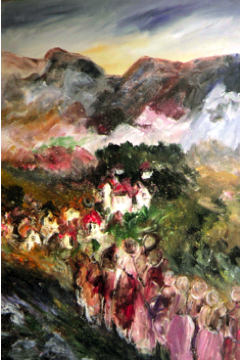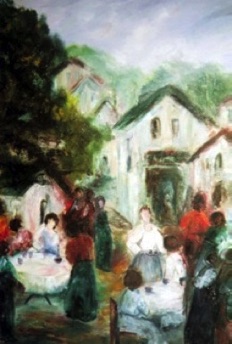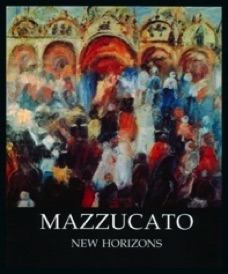THE HORIZONS OF CARLA CARLI MAZZUCATO
by Jul Bruno Laner
Art Historian, Bolzano, Italy
Artists stand on the threshold of times, eras, moods and worlds, and therefore, especially now as we sit astride two millennia, they function as societal seismographs. Through their sensibilities, they intuit the drift and direction in which society is moving: toward new horizons or toward gloomy shadows of the past.
Carla Carli Mazzucato was molded by life itself to look toward new horizons. In her native country, at the foot of the Dolomites, which were labeled by Le Corusier as the world's most beautiful architecture, she came to know even as a child many horizons in the form of gentle hills, wooded mountains, rocky peaks and vast glaciers.
In her painting, “Sounds of the Valley,” memories of her native homeland resurface. This land where she was born is a place where three cultures meet and those who live here must overcome lingual barriers and communicate in Italian, German and Ladino.
Mazzucato
classic art — contemporary vision
Art Critique - Mazzucato: New Horizons (published U.S.A.) - 1994

For Carla, the beauty of nature and the transiency of youth are free from bittersweet romanticism; instead, with stylistic elements that recall expressionism, she opens the gate in her painting, “Sounds of Youth,” toward a future in which humanity, Mediterranean harmony, youth and resplendent nature mingle joyously. All her works are painted with a good measure of bold character, dynamic strokes and fascinating gradations both in color and composition. Then, with shades of red she imbues her painting with her own rhythm and spirit.
Carla Mazzucato is no Cassandra; she does not paint any images of a grim Dante inferno. She fuses man and landscape, but in a positive vision full of hope, and it is this that is reflected in the episodes and stories that unfold in her paintings and graphic works.

The artist spent her childhood in a region rich with art, found everywhere along the road travelled by emperors of the Holy Roman Empire on their way to coronation in Rome. Surrounded by art—Romanesque, Gothic, Renaissance and Baroque—she was subtly influenced by her surroundings, even by the graceful sixteenth-century house of her father and the music of her sister Lidia, an accomplished pianist and music professor. And certainly her studies in humanities at the University in Milan helped her discover many new horizons.
This socio-cultural foundation is evident in many of the artist's paintings. Sometimes it even shows itself at a level deeper than the rich technique that brings it to life: a feast of grapes, an Autumn bacchanalia leaps from the canvas of “Harvest Celebration,” in which casks of wine represent more than just wooden containers, they are symbols of secret rites, those which unite all people in their most primal of rituals, “Celebration.”

She loves the freeness of nature, people enjoying each other's company. She gives her figures form, brushed with her vision, and melds them into her sceneries like her colors. Through the expressive tone of “Afternoon,” we sense the anticipation of an imminent event, something magical; but the figures wait without apprehension, almost calm, the sky clear of any foreboding storm clouds. The colors are tempered and soft so as not to disturb the peace of the moment.
“St. Anna Square” revisits a state of mind harkening back to the artist's homeland where wine springs from the vine and the mountains rise from the plains. But this place, this depicted feeling, can ring true for humanity in any other part of the world. A lyric harmony, fills the town square: greetings, conversations in hushed tones, communication and understanding are realities as vital as the air in the great, gentle world on the canvases of Carla Mazzucato.
Through her paintings—the images of towns, groups of people, rows of houses—we can see that a true master is at work, not to define a reality, but to attempt to evoke in those who would see and listen, a visual melody in tune with her world, or at very least, to prompt them to willingly glance through that window of possibility opened by her art.
We should hope that the future will agree with her vision, and that humanity, together with the figures of people “Along the Village Road” of Carla Mazzucato, will encounter endless horizons in the third millennium.
translation: pvm
Sounds of the Valley
St. Anna Square



